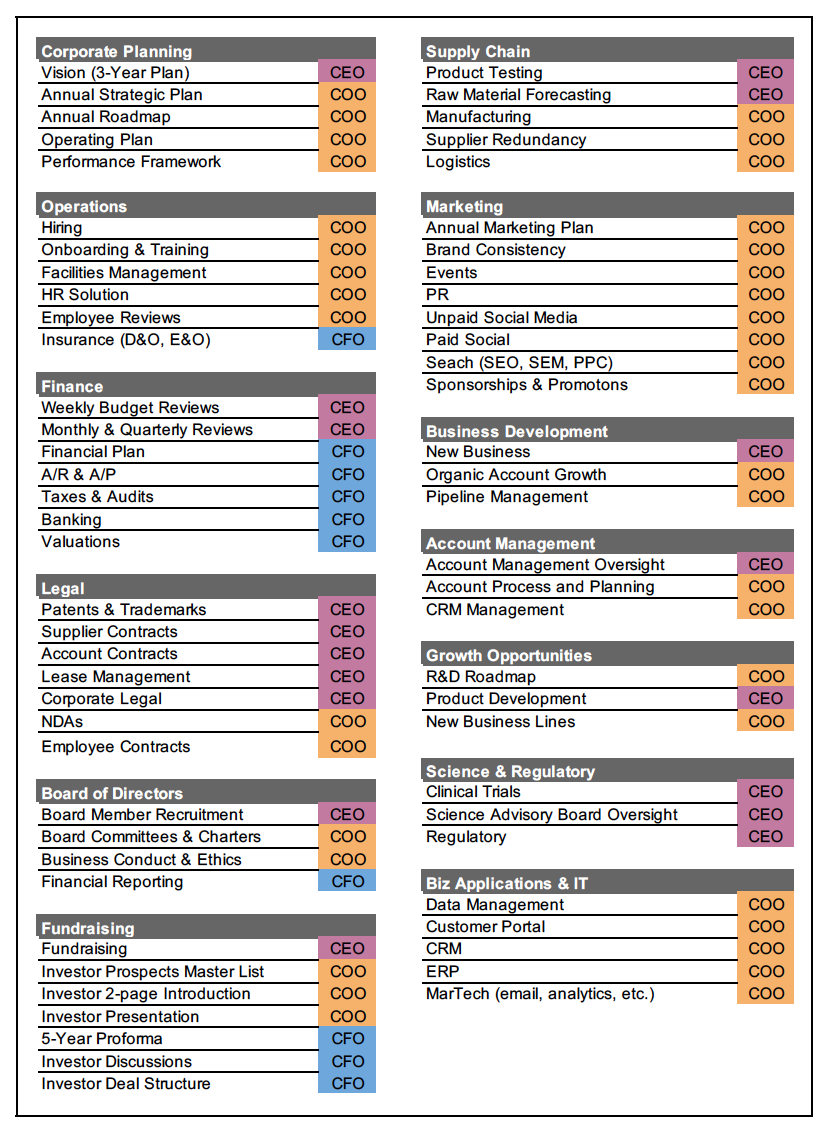The CEO-COO partnership is one of the most critical success factors for a business and, yet, it’s not often discussed. There’s a paltry amount of information online about how to structure this meaningful working relationship. During my career, I’ve had the great fortune to serve as the right hand for several CEOs. Each partnership was different and had its unique qualities; however, there were a handful of common factors that made them all successful. I believe these elements constitute a formula for a successful c-suite partnership.
What Does a Chief Operating Officer Do?
A Chief Operating Officer (COO) is a senior executive responsible for the day-to-day administration and operations of a business. The COO reports directly to the company’s Chief Executive Officer (CEO). To analogize it, the CEO is the corporate commander in chief, and the COO is the second in the chain of command. And this is where all common definitions of the COO role start and end.
While there’s a universal understanding of the responsibilities of other c-suite positions (CMO, CFO, CTO), the definitions of the COO role vary widely. Harvard Business Review’s seminal article, Second in Command: The Misunderstood Role of the Chief Operating Officer, by Nathan Bennett and Stephen A. Miles, states that, based on their research, there are seven, non-mutually exclusive COO archetypes:
- The Executor (executes the CEO’s strategy)
- The Change Agent (focuses on business transformation)
- The Mentor (coaches an inexperienced CEO)
- The Other Half (serves as a counterpart to the CEO)
- The Partner (leads the organization in concert with the CEO)
- The Heir Apparent (is being groomed to assume the CEO role)
- The MVP (is promoted to the c-suite so as not to lose this indispensable team member to another company)
So why are there so many COO models? I’ve long pondered this and believe it depends upon, first, the state of the organization at the time the COO is brought on board and, second, the type of operational leader who is best suited to complement the CEO and strengthen that person’s leadership at that juncture. Ben Horowitz in his book, The Hard Thing About Hard Things, explains that there are two types of situational CEOs — the Peacetime and the Wartime. The Peacetime CEO is at the helm when the company has a competitive advantage and is growing. The Wartime CEO is weathering a corporate storm. Add to that the fact that each CEO has different strengths and weaknesses and it stands to reason that CEOs seek seconds who are the yin to their yang, and are appropriate for the company at a specific inflection point.
I’ve experienced this first-hand. Two-thirds of the CEOs I’ve supported have been big picture visionaries who were more than happy to leave the minutiae of running day-to-day operations in the hands of the COO. The other third enjoyed digging into the details. And the Wartime CEO’s, the ones defending the company from real market threats, were highly involved — one in personally shaping the product; the other with directly overseeing sales. Suffice it to say that, just like any relationship, there is no one right way. Nevertheless, in my experience, several elements can help create a successful CEO-COO pairing.
The CEO-COO Success Formula
Division of Responsibilities
One of the most critical activities the CEO and COO can undertake when they first start working together is to have an honest and open conversation about each other’s strengths, weaknesses, interest areas, and expectations, and then map that knowledge into an initial matrix of responsibilities. This model becomes the first draft of the operating manual for how the CEO and COO will interact, dictating what they respectively focus on, and outlining how they divide responsibility within the organization. It’s vital that this division of labor be communicated clearly and early on to the team. It will alleviate confusion as to who oversees what aspects of the organization, and will also avoid the “mom vs. dad” syndrome where employees make an end-run around the COO and go directly to the CEO to get the response they want.
 I simply love the article, How My Co-Founder and I Structure Ourselves as CEO and COO, by Joel Gascoigne, the CEO at Buffer. In it, Joel describes the journey on which he and his co-founder, Leo Widrich, embarked to determine how to divide responsibility. They ultimately realized they could shape their roles to reflect their strengths, and that worked for them. Critical Eye also has an informative article, The Hidden Value of the COO, in which various COOs explain their respective scopes of responsibilities and how they divide up work with their CEOs. And Bridgespan’s article, COO Roles & Structures: Stories from the Field, offers excellent case studies on how different CEO-COO pairings have decided to split their duties.
I simply love the article, How My Co-Founder and I Structure Ourselves as CEO and COO, by Joel Gascoigne, the CEO at Buffer. In it, Joel describes the journey on which he and his co-founder, Leo Widrich, embarked to determine how to divide responsibility. They ultimately realized they could shape their roles to reflect their strengths, and that worked for them. Critical Eye also has an informative article, The Hidden Value of the COO, in which various COOs explain their respective scopes of responsibilities and how they divide up work with their CEOs. And Bridgespan’s article, COO Roles & Structures: Stories from the Field, offers excellent case studies on how different CEO-COO pairings have decided to split their duties.
Keep in mind that, like any relationship, the CEO-COO partnership will evolve and thus the division of responsibilities isn’t static. Perhaps, the COO’s knowledge of the industry and his connections have grown to allow him to step into a fundraising role. Maybe, the CEO feels like a struggling division needs a direct injection of her DNA to reinvigorate it. As the CEO-COO relationship develops and responsibilities shift, these changes must be communicated to the team.
Trust and Respect
While each of the CEO-COO partnerships I’ve been in has differed dramatically, each instance has been underpinned with a foundation of trust and respect. There’s always been an understanding that, at the executive level, you can vehemently argue your point of view behind closed doors, however, once a determination has been made about what’s best for the company, everyone leaves the room fully supporting that decision. The CEOs with whom I’ve worked knew that I fully supported them and that, even when our perspectives differed, we present a united front and I would represent their interests fully when they weren’t in the room.
Communication
In some respects, the CEO-COO partnership is like a marriage. And, what’s the secret to a successful relationship with your life partner? I would offer that the answer is communication. In the corporate world, having a regular dialogue is just as important. It’s critical the CEO and COO establish a conversational cadence to ensure they’re in lockstep. The COO must understand a CEO’s continually evolving vision and strategy in order to execute upon it. Likewise, to build and maintain trust, the CEO needs frequent operational updates from the COO to have confidence that the strategic plan is being operationalized in keeping with that Northstar vision.
Reasonable Patience
A COO isn’t brought into an organization if there isn’t the need for operational oversight. Technology is disrupting every single industry, and business adaptation is a must for any sustainable enterprise. Accordingly, the CEO must have a bold vision, and the COO must have an ambitious yet achievable operational plan to realize that future state. Change doesn’t happen overnight — it’s a series of smaller steps that ladder up to transformation. Much like how it’s hard to see your child grow taller, because change is subtle when you witness it unfolding every day, the morphing of an organization can be hard to recognize as well. In Supercharge Your CEO/COO Relationship, David Townsend, President & COO of Awecomm, posits that in order for a COO to be successful, he needs to report measurable progress on a regular basis and the CEO needs to believe in the COO’s roadmap and understand that organizational change doesn’t happen over night.
Now that we know the formula for CEO-COO partnership success, how do you put this magic equation into practice? Based on my experience, I’ve compiled a list of what I believe are the key commitments the CEO and COO should respectively make to the partnership.
The CEO’s Commitment to the Partnership
Provide Access
Time spent together is arguably the single most effective way for a CEO and COO to synch. Upfront jam sessions are needed to connect initially and for the CEO to explicate her vision. However, once that relationship is established, and the COO understands and is effectively running operations, it’s just as critical these two executives maintain a regular meeting schedule. A CEO’s view on the industry and where the company is heading is never fixed, and the COO needs to keep pace with that evolving vision.
Empower Your Second
Once you’ve determined you’ve hired the right person for the COO role, grant that individual real decision-making power over the aspects of the business that fall within his or her purview. The fastest way for a COO to fail is when he loses credibility. And, the quickest way to lose credibility is when the CEO publically second-guesses the COO’s authority and/or allows team members to do end-runs and overturns the COO’s previous decisions. For a COO to succeed, he must have the CEO’s full support and the team must know that the buck stops with him.
Acknowledge
Overseeing operations can often be a thankless job. Few people express gratitude when things, that are supposed to go right, do. On the other hand, people are quick to point out missteps and failures. The CEO needs to recognize and celebrate the COO’s successes.
The COO’s Commitment to the Partnership
Earn & Maintain the Team’s Trust
If you’re starting a new role as a COO, it’s imperative you win the team’s trust early on. Even though the demands of your new position may be overwhelming, there is always low-hanging fruit. Ensure you carve out enough time to identify these quick wins so you can demonstrate immediate momentum and gain the team’s faith. Once you’ve attained it, you need to communicate measurable progress against goals to maintain that confidence continually.
Operate Without Ego
As COO you have a tremendous amount of responsibility, but you are not the CEO. Your role is to fully support the CEO without trying to take her glory or step into her position. A CEO can’t fully trust a COO if she sees that person as a threat to her leadership. Bottom line, know your swimlane — your role as COO is to support and confidently deliver on the CEO’s vision.
Tangibly Visualize Success
The CEO should have a big vision. Operationalizing that is not a trivial task and delivering on a grand idea is much easier when you can visualize desired results. Most CEOs are great at articulating an inspiring vision, but many lack the skills to paint a detailed picture of success. This is where the COO can help by backward engineering that future state of what winning looks like into an annual strategic plan and prioritized roadmap that focuses on high-value initiatives. These documents will serve as guideposts for the team.
Serve as a Sounding Board
The top role can be a lonely place. For CEOs, it’s difficult to find peers with whom they can discuss fears and out-of-the-box ideas. Whenever desired, the COO should serve as a consigliere for the CEO to talk through unconventional concepts, develop risk mitigation strategies, and provide operational perspectives that support the vision.
Be Data-Driven
Operations boils down to doing the right things, and doing those things right. A CEO is more likely to look at weak signals in the marketplace that telegraph white space that might be occupied for competitive advantage, while the COO is all about the numbers. He must embed a measurement framework that provides data on every aspect of the business, and then he must derive insights and make them actionable.
In summary, the CEO-COO marriage can be the most beneficial relationship for the health and long-term viability of an organization. In order for this partnership to flourish, it requires a clear division of responsibilities, rapport built on mutual trust and respect, free-flowing and frequent communication, and the time needed for a true bond to form.









